Art of Don ca tai tu music and song in the South of Viet Nam
Art of Don ca tai tu music and song in the South of Viet Nam (also known as Don ca tai tu) is a specific folk art type of Viet Nam, developed in the South region in the late nineteenth century. People in Southern Viet Nam consider Don ca tai tu as an indispensible spiritual cultural activity in festivals, death anniversary rituals and celebratory social events like weddings and birthdays... The death anniversary of the ancestors held annually on the twelfth day of the eighth lunar month.

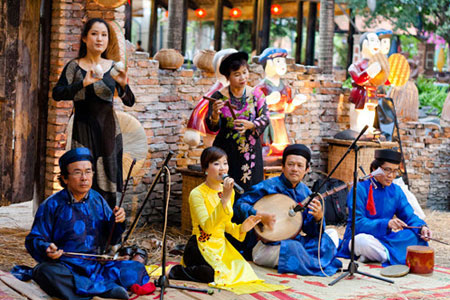
Don ca tai tu has been influenced by some other forms of cultural heritage from the Central and South of Viet Nam such as ceremonial music (nhac le), classical theatre and folk song (hat boi). The repertoire of Don ca tai tu is based on 20 principal songs (bai to) and 72 classical songs (bai nhac co).
Instruments for Don ca tai tu performance include the moon-shaped lute (kim), two-stringed fiddle (co), 16-string zither (tranh), pear-shaped lute (ty ba), percussion (song lang), monochord (bau) and bamboo flute (sao). The violin and guitar are adapted. Don ca tai tu is performed within hereditary musical families and by music ensembles and clubs. The audience can join practicing, making comments or creating new song texts.
Don ca tai tu practitioners include master instrumentalists (thay don), master lyricists (thay tuong), master singers (thay ca), instrumentalists (danh cam) and singers (danh ca).
According to the inventory implemented in 2011, Don ca tai tu is practiced in more than 2,500 clubs, groups and families in 21 provinces and cities in the South of Viet Nam
On 5 December 2013, at the 8th session of the Intergovernmental Committee for the Safeguarding of the Intangible Cultural Heritage held in Baku City (Azerbaijan), UNESCO recognized officially Don ca tai tu as Intangible Cultural Heritage of Humanity.
Xoan Singing
Xoan singing (also called hat cua dinh, lai len singing, dum singing, tho singing…) is a kind of performing art, attached to cult of worshipping Hung Kings and performed by farmers growing wet rice in the midland areas, mainly in Phu Tho Province.

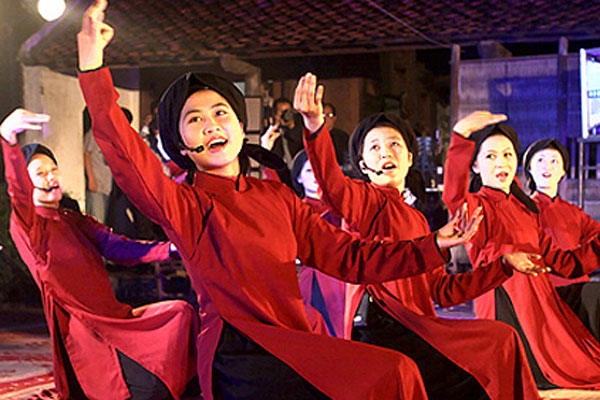
Xoan singing was originated in several localities in Phu Tho Province, including guilds of Phu Duc, Kim Doi, Thet (Kim Duc Commune) and An Thai (Phuong Lau Commune), Viet Tri City. There are three forms of Xoan singing as the worship singing to commemorate Hung Kings and village guardian gods; the ritual singing to pray for good crops, good health; and the festive singing – a form of love duet.
Often practiced in spring, Xoan singing is a combination of poetry, music, singing, dancing. There exists tight attachment between poem and rhythm, the meaning of poem unites with music. Xoan singing has three types: recital melody (hat noi); chanting melody (hat ngam ngoi) and praising melody (hat xuong).
Xoan singing is organized into Xoan guilds, each including 15-18 people, of which are 2-9 male instrumentalists called kep, and 6-12 female singers called dao. Each guild is headed by an old man who has a thorough knowledge of Xoan singing, referred to as Trum.
A performance of Xoan singing normally comprise of three phrases: Worship singing, Ritual singing (or qua cach singing) and Festive singing. Props of Xoan guilds include little bottles of wine, paper fans and a book of 14 qua cach (folk melodies) written in Nom script. Instruments include a small drum, a big drum and a few pairs of clappers.
On November 24th 2011, at the 6th meeting of the Inter-governmental Committee for the Safeguarding of the Intangible Cultural Heritage of UNESCO held in Bali, Indonesia, Xoan singing in Phu Tho was officially recognized as Intangible Cultural Heritage in Need of Urgent Safeguarding.
Nha nhac, Vietnamese Court Music - An Intangible Cultural Heritage
On November 7, 2003, UNESCO bestowed world heritage status on 28 relics of nations as masterpieces of oral and intangible heritage of humanity. Among the 11 masterpieces of Asia, nha nhac (royal music) represents the first intangible legacy of Viet Nam to have been put on this list.

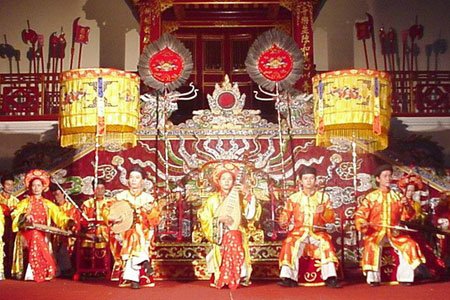
The UNESCO Council appraised Vietnamese royal music in the following terms: “Vietnamese royal music represents an elegant and refined music. It deals with the music performed in the imperial courts and on different anniversaries, religious festivals, and on such particular occasions. Of the different categories developed in Viet Nam, only the royal music was national.”
Nha nhac (Vietnamese royal music) and its principles came to Viet Nam under the Ho Dynasty (1400-1407). The Ho Dynasty, however, only existed for a short time, so nha nhac rapidly fell into oblivion. In 1427, Le Loi defeated the Chinese Ming invaders and liberated the country. However, nha nhac only began to develop in the reign of King Le Thanh Tong (1460-1497) and reached its peak under the Nguyen Dynasty (1802-1945).

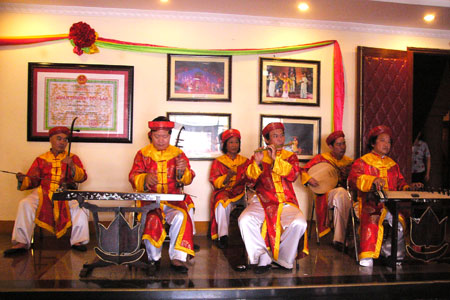
Nha nhac is genre of scholarly music. It attracted the participation of many talented songwriters and musicians, with numerous traditional musical instruments.
From now on, nha nhac will have opportunities to preserve, develop and popularize to the public, inside and outside the country.
Ca Tru
Young people now enjoy new music that comes to them from the radio, television, audio and video tapes, as well as compact discs. So, do they still show any attachment to the old folk tunes so loved by their elders, such as the melodies of ca tru? Ca tru is a musical genre that calls for expertise as well as sensibility on the part of the listeners. In return, it provides the most refined enjoyment.

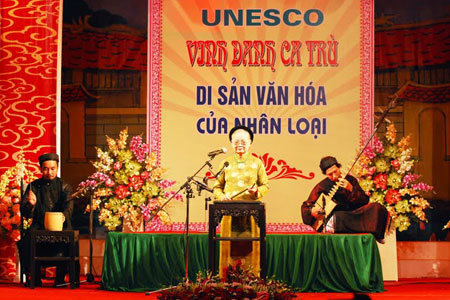
Fortunately, ca tru is now being restored and is more liked by the younger generation. Research scholars have traced the origins of ca tru to areas of high culture, such as the ancient imperial capital of Thang Long (present-day Ha Noi), etc. Artists of great talent have practiced the art, including Quach Thi Ho, Thuong Huyen, Kim Dzung, etc. Some of them are now in their seventies, but a successor generation has blossomed and holds great promise.
Ca tru is where poetry and music meet. People familiar with such ancient verse as luc bat (the six eight-syllable distich) and hat doi (singing tossed back and forth between groups of young men and women), and who are capable of sympathizing with the sentiments expressed in the sound of a small drum or a two-string viol, are more likely to fully enjoy a recital of ca tru.
Many famous poets of past centuries were great amateurs of ca tru who wrote beautiful lines to go with its melodies. One well known instance is the poem singing the enchantment of a pilgrimage to Chua Huong (Perfume Pagoda) by Chu Manh Trinh. Coming from the lips of a ca tru singer, it has bewitched successive generations of pilgrims visiting the hills and streams of the famous pagoda complex in Ha Noi.

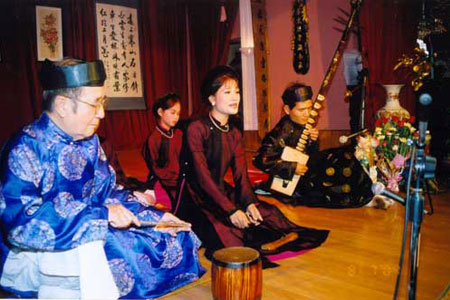
Ca tru music is most enjoyable when there is complete harmony between the words being sung, the rhythm marked by a pair of small bamboo sticks held by the singer who strikes a small block of wood or bamboo called phach, and, last but not least, the appreciation shown by a man among the audience beating a small drum at the appropriate moments.
In short, ca tru is a refined form of art which is paradoxically appreciated and loved by audiences of all compositions. There are those who sit in small numbers in an urban auditorium to enjoy a recital. A Ca Tru Club has been founded in Ha Noi where amateurs of this musical genre, young and old, local and foreign, regularly meet to enjoy its charming melodies.
Ca tru singing is inscribed on the list of Intangible Cultural Heritage in need of Urgent Safeguarding on 1st October 2009.
Quan Ho
The birth place of quan ho folk songs is Bac Ninh Province. During village festivals, which are held every year, particularly in spring, young men and women gather in the yard of a communal house or pagoda, on a hill or in a rowing boat, and sing quan ho. This is a style of singing where songs alternate from group to group.

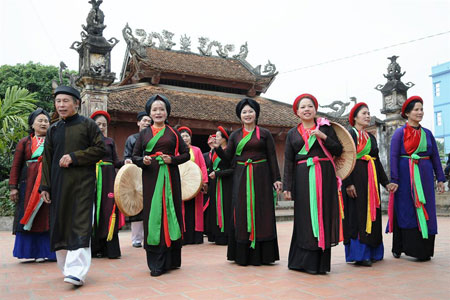
Quan ho singing is a folk art of a highly collective nature. Those who sing are not entertainers, but all are part of the performance, and anyone is welcome to join.

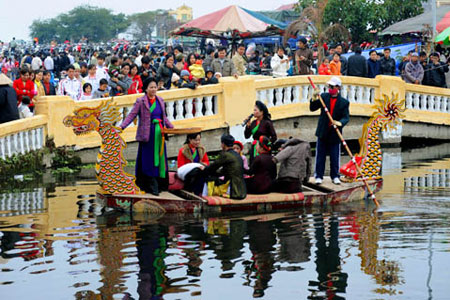
Quan ho Bac Ninh folk songs is inscribed on the list of Representative List of the Intangible Cultural Heritage of Humanity on 30th September 2009.
Water Puppets
Vietnamese water puppetry has a long history. An inscription on a stone stele in Doi Pagoda, Duy Tien District, Nam Ha Province, relates a water puppet show staged in the year 1121 to mark a birthday of King Ly Nhan Tong in 4036 words.

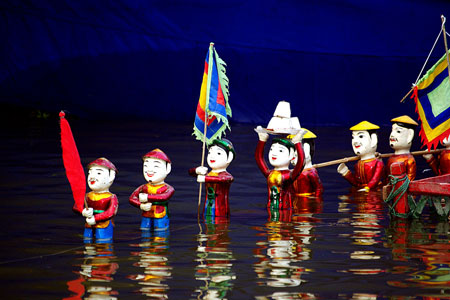
Puppets are made of wood and coated with waterproof paint. Each puppet is handmade, has its own posture and expresses a certain character. The most outstanding puppet is known as chu teu which has a round face and a humorous and optimistic smile. The show starts with chu teu, dressed in an odd costume, offering joyful laughter.
The pond and lakes of the northern plains, where crowds gathered during festival and galas, become the lively stages for the water puppet shows. At a water puppet show, the audience watches boat races, buffalo fights, fox hunts and other rustic scenes amidst the beating of drums and gongs. The characters plough, plant rice seedlings, fish in a pond with a rod and line, scoop water with a bamboo basket hung from a tripod, etc. The show is interspersed with such items as a Dance by the Four Mythical Animals: Dragon, Unicorn, Tortoise, and Phoenix and Dance by the Eight Fairies, in which supernatural beings enjoy festivities alongside people of this world.
 In water puppet shows there is a very effective combination of visual effects provided by fire, water, and the movements of the marionettes. The whole control system of the show is under the surface of the water, concealed from the audience. When fairy figures appear to sing and dance, it is calm and serene; then the water is agitated by stormy waves in scenes of battle, with the participation of fire-spitting dragons.
In water puppet shows there is a very effective combination of visual effects provided by fire, water, and the movements of the marionettes. The whole control system of the show is under the surface of the water, concealed from the audience. When fairy figures appear to sing and dance, it is calm and serene; then the water is agitated by stormy waves in scenes of battle, with the participation of fire-spitting dragons.
There are many contributing factors to the art of water puppetry, including such handicrafts as wood sculpture and lacquer work. The factors all work together to bring out charming glimpses of the Vietnamese psyche, as well as typical landscapes of Viet Nam.
Cheo or Vietnamese Popular Theatre
Cheo is a form of stage performance that originated in the northern countryside. The word cheo means “lyrics of folk ballads, proverbs”.

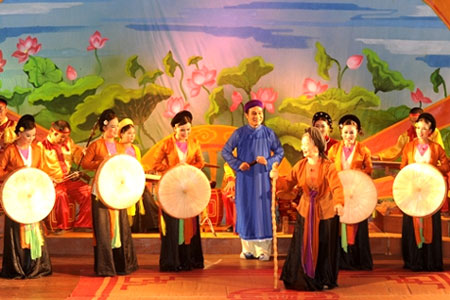
Traditionally, cheo was composed orally by anonymous authors. Today's playwrights compose cheo along traditional lines. The characters in the plays sing time-tested popular melodies with words suited to modern circumstances. Human rights and the battle of good against evil are common themes. The joyfulness and optimism of cheo is expressed through humour and wit.
In cheo performances, there is always an exchange between the audience and the performers. The performers, dao (actress), kep (actor), lao (old man), mu (female character) and he (buffoon).
At present cheo is an integral part of Vietnamese theatre and is well liked by people in both the country and in towns, and by foreign spectators as well.

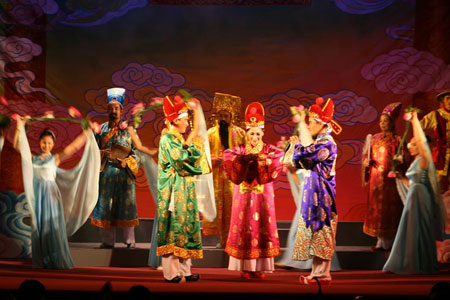
The buffoon in Cheo
The buffoon is a familiar character in cheo, in which there is often a blend of the tragic and the comic. He speaks the language of the people and shoots shafts of satire at evil-doers, such as ignorant witchdoctors, greedy landlords, or arrogant mandarins. He may wear a short coat, the garment of the commoner or a long robe, an article of clothing favoured by members of the upper classes in the old society. A couple of buffoons may appear on stage, including the master in a flowing gown and his servant in a short coat and carrying a stick, each speaking the language and behaving the ways of his class. The buffoon may make his entry right at the beginning of a play, carrying a torch or a megaphone and provoking wild laughter from the audience.
Cheo is now undergoing a strong revival. It is particularly relished by foreigners by overseas Vietnamese visiting the country.
Cai Luong
Cai luong is a kind of folk music that developed in the early 20th century. It was first played by amateurs in the south. Thanks to their soft voices, southerners sing cai luong very romantically.

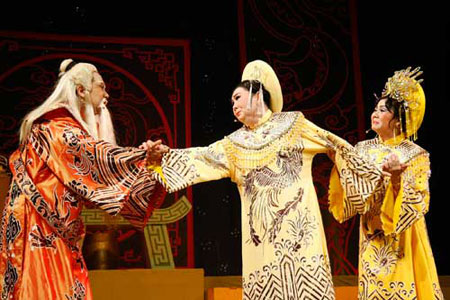
The performance includes dances, songs, and music; the music originally drew its influences from southern folk music. Since then, the music of cai luong has been enriched with hundreds of new tunes. A cai luong orchestra consists mainly of guitars with concave frets and danakim.

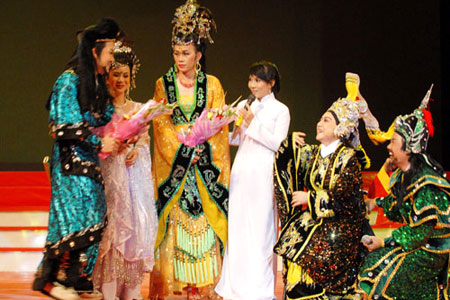
Over time, cai luong has experienced a number of changes to become a highly appreciated type of stage performance.
Classical Opera or Tuong
Tuong, also called hat boi in the south, is a stage performance that came about during the Ly-Tran dynasties and that became very popular nationwide during the following centuries.

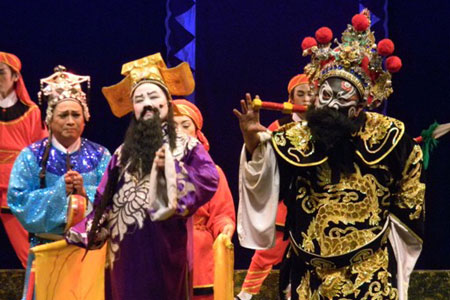
During the Nguyen dynasty, 19th century, tuong occupied a good position in the cultural lives of the royals. In tuong, space and time are captured by songs, dancing, and simple music. In the past, tuong did not require any elaborate stage accessories; now, however backdrops and make-up are more elaborate and sophisticated.

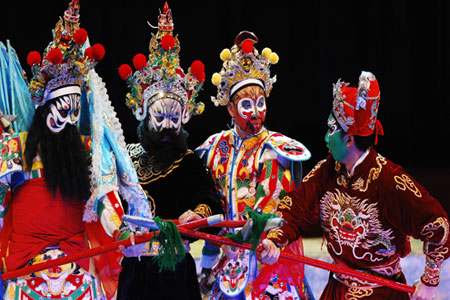
Hat Van
Hat van or hat chau van, a traditional folk art which combines singing and dancing, is a religious form of art used for extolling the merits of beneficent deities or deified national heroes. Its music and poetry are mingled with a variety of rhythms, pauses, tempos, stresses and pitches.
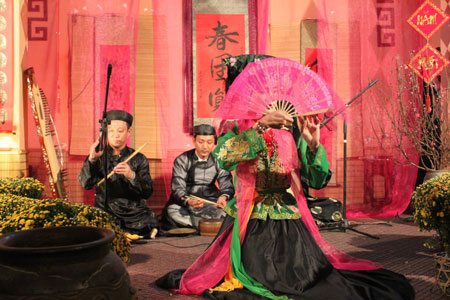

Hat van, in essence, is a cantillation where the tunes and rhythm depend on the contents of the sung text. The tunes and rhythms may be linked together into a suite, used in relation to a mythical occurrence with hints of features from modern life.
The breathing of a hat van singer comes from his or her midriff to nasal cavity, which works as a resonance box and creates an effect appropriate for religious subjects, particularly when heard in an atmosphere of incense and candles.
The words of the chanting must be clear enough so that all those attending the ceremony are able to understand. There are two kinds of hat van: hat tho and hat len dong.
Hat tho is the chanting accompanying an act of worship. Hat tho is slow, serious, and dignified. Variations in the music are few and contain little contrasting pitch and stress.
Hat len dong accompanies psychic dancing claiming to respond to occult powers and expressing the will and orders of some supernatural being. It may contain many variations depending on the number of verses sung, often coming to a climax or slowing down to the tempo of a meditation.
The music instrument accompanying hat van plays a very important role, in emphasizing important passages or creating contrasting effects; in any event, the music enriches the content of the chant.
The main instrument used is the dan nguyet or moon-shaped lute, accompanied by the striking of the phach (a piece of wood or bamboo), xeng (clappers), trong chau (drum) and chieng (gong) marking the rhythm. Use may also be made of the 16-stringed zither thap luc and flute sao in the recitation of certain poetry, and of the eight-sound band dan bat am in certain ceremonies.
The dress worn by hat van singers, based on the cult of the "four palaces", includes a red robe for the cult of the "heavenly palace", a yellow robe for the "underground palace", a green robe for the "musical palace" and a white robe for the “aquatic palace". The style of the robe and the headgear is related to the rank of the supernatural being honoured in the act of worship. Over time, the style of the costume may vary but the rules about the colours have remained unchanged.
The art of hat van originated in the Red River Delta and dates back to the 16th century, later spreading to the whole country. It has also adopted the essential beauty of folk songs from the uplands and highlands of the North, Center and South.
Hat van requires both a learned and a folksy character, and it has attracted musicologists at home and abroad.
Source: www.vietnamtourism.com